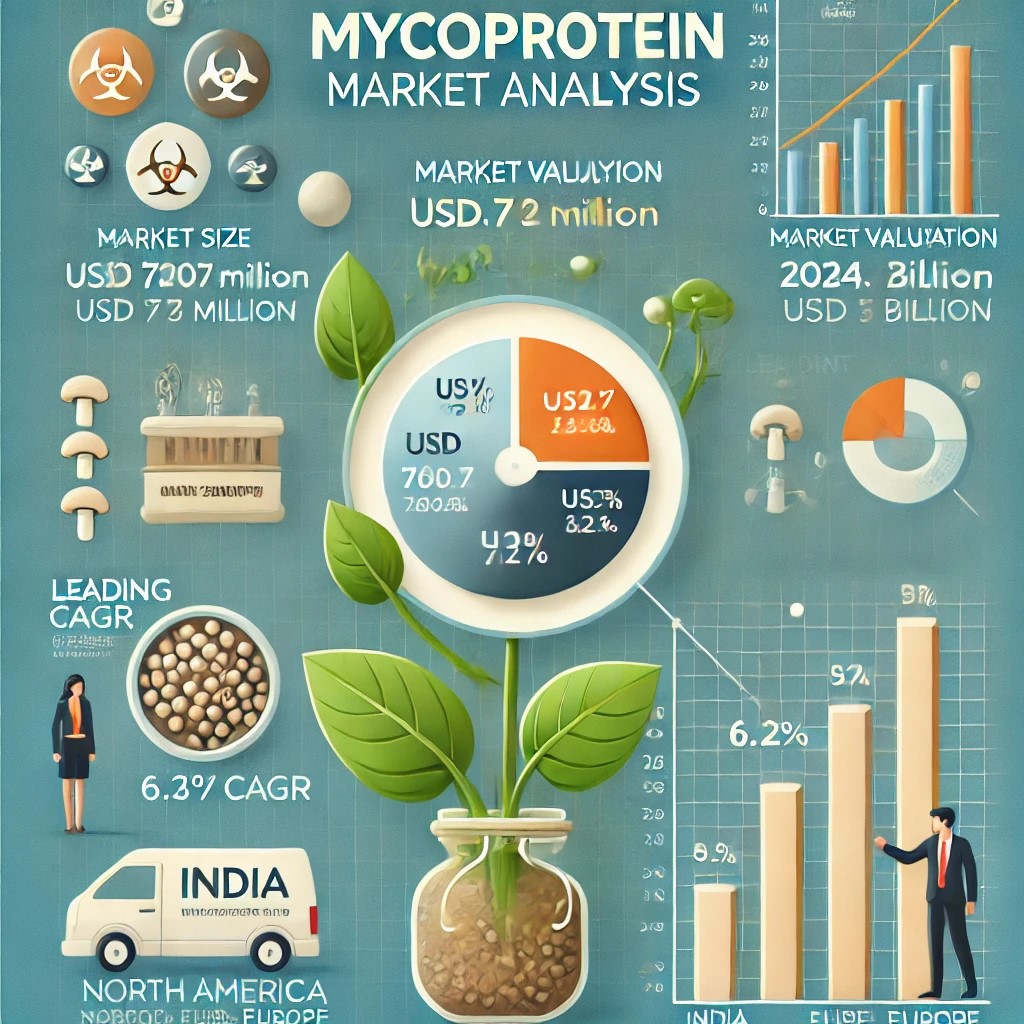The mycoprotein market in the United States is projected to grow at a 5.5% CAGR through 2034, driven by the increasing adoption of vegan and vegetarian diets. As consumers shift towards plant-based protein sources, mycoprotein has emerged as a popular meat alternative, offering a high-protein, sustainable option. Its positioning as a superior alternative in plant-based diets is boosting its demand in the U.S. market
NEWARK, Del, Sept. 09, 2024 (GLOBE NEWSWIRE) — The global mycoprotein market share is set for significant growth, projected to increase from USD 720.7 million in 2024 to USD 1.32 billion by 2034. Driven by increasing demand for plant-based proteins and sustainable food production, the market is expected to grow at a compound annual growth rate (CAGR) of 6.2% during the forecast period.
The growing number of people adopting vegan and vegetarian diets is a key factor driving the demand for mycoprotein. Mycoprotein is suitable for people with various dietary restrictions, further broadening its appeal, as more consumers seek plant based protein sources.
The surging popularity of food delivery services presents an opportunity for mycoprotein manufacturers to partner with online platforms and meal kit companies. Companies, by offering mycoprotein based meal options through these channels, can reach a wider audience and capitalize on the convenience trend driving the food delivery market.
The growth potential of the mycoprotein market has attracted investment from both established food companies and venture capitalists. Collaborations between food manufacturers and biotech companies are scaling up innovation and accelerating the development of new mycoprotein based products.
Food manufacturers are increasingly incorporating mycoprotein into a variety of products, including burgers, sausages, nuggets, and ready to eat meals. The diversification of product offerings is expanding the market reach of mycoprotein and attracting new consumers who are looking for convenient and tasty plant based options.
Continuous improvements in cultivation techniques, such as using novel substrates and optimizing fermentation conditions, are enhancing the yield and quality of mycoprotein, making it more economically viable for mass production.
Leveraging scientific research and clinical studies, companies can substantiate health claims and highlight the functional benefits of mycoprotein, such as its potential to support muscle growth, weight management, and gut health. Government initiatives promoting sustainable food production and healthier diets are driving the adoption of alternative protein sources like mycoprotein.
Incorporating bioactive compounds or fortifying mycoprotein with vitamins and minerals can further enhance its nutritional profile and appeal to health conscious consumers.
Country-wise Insights
The following table illuminates the growth rate of the industry in certain countries, with Japan and India slotted in to post favorable growth numbers. The countries will lead the market through 2034.
| Countries | Forecast CAGRs from 2024 to 2034 | |
| The United States | 5.5 | % |
| Germany | 5.9 | % |
| China | 6.1 | % |
| Japan | 6.7 | % |
| India | 7.3 | % |
Key Takeaways from the Mycoprotein Market Study
- Global mycoprotein market was valued at USD 1 million in 2023.
- From 2019 to 2023, the market demand expanded at a CAGR of 5.8%.
- The market in Japan to expand at a CAGR of 6.7% through 2034.
- By type, the food grade segment to account for a share of 55.2% in 2024.
- The market in India will expand at a CAGR of 7.3% through 2034.
- By form, the minced segment to account for a CAGR of 55.3% through 2034.
“Advances in fermentation technology and genetic engineering are driving efficiencies in mycoprotein production, leading to cost reductions and scalability,” – says Nandini Roy Choudhury, Client Partner at Future Market Insights

Prominent Drivers of the Mycoprotein Market
- Rising Demand for Plant-Based Proteins: The growing trend towards vegan and flexitarian lifestyles is driving demand for plant-based proteins like mycoprotein, which serves as a meat alternative for health-conscious consumers.
- Sustainability: With increasing global focus on sustainable food production, mycoprotein is viewed as an eco-friendly alternative to traditional meat products, helping reduce carbon footprints.
- Product Innovation: Advancements in taste, texture, and functionality of mycoprotein products have led to greater market penetration, especially in processed foods, meat analogues, and ready-to-eat products.
- Health Awareness: Mycoprotein’s health benefits, such as low-fat content and high protein value, are attracting health-conscious consumers, fueling market growth.
Browse full Report: https://www.futuremarketinsights.com/reports/mycoprotein-market
Challenges Faced by the Mycoprotein Market
- High Production Costs: Mycoprotein products are priced higher than traditional meat options, limiting their accessibility to a broader consumer base.
- Limited Consumer Awareness: A lack of consumer knowledge about the nutritional and environmental benefits of mycoprotein is slowing market adoption in certain regions.
- Allergies and Sensitivities: Allergic reactions caused by fungi-based mycoprotein present a challenge, especially for consumers with mold allergies, impacting the growth potential of the market.
Competitive Landscape
Prominent players in the mycoprotein market are Marlow Foods Ltd, 3F Bio Ltd., Tyson Ventures, MycoTechnology, Inc., Temasek Holdings, General Mills, Beyond Meat Inc., Impossible Foods Inc., Quorn Foods, Marlow Foods Ltd, Yutong Industrial Co. Limited, Shouguang Ftl Bio. Co., Ltd., Symrise, and Kernel Mycofoods, Atlast Food Co., among others.
Company Portfolio
- Tyson Ventures, a venture capital arm of Tyson Foods, is involved in investing in innovative food technologies, including those related to mycoprotein. While Tyson Foods is traditionally known for its meat based products.
- MycoTechnology, Inc. specializes in developing and commercializing food and beverage ingredients derived from fungi, including mycoprotein. Their flagship product, PureTaste®, is a mycelium based protein that can be incorporated into a variety of food and beverage applications.
More Valuable Insights Available
Future Market Insights offers an unbiased analysis of the global mycoprotein market, providing historical data for 2019 to 2023 and forecast statistics from 2024 to 2034.
To understand opportunities in the mycoprotein market, the market is segmented on the basis of form (minced, slices), sales channel (supermarkets / hypermarkets, convenience stores, specialty stores, online stores), and type (feed grade, food grade), across seven major regions (North America, Latin America, Western Europe, Eastern Europe, South Asia & Pacific, East Asia, and the Middle East & Africa (MEA)).
Segmentation Analysis of the Mycoprotein Market
By Form:
By Sales Channel:
- Supermarkets/Hypermarkets
- Convenience Stores
- Specialty Stores
- Online Stores
By Type:
By Region:
- North America
- Latin America
- Western Europe
- Eastern Europe
- South Asia and Pacific
- East Asia
- The Middle East and Africa
German Translation:
Der weltweite Marktanteil von Mykoproteinen wird voraussichtlich von 720,7 Mio. USD im Jahr 2024 auf 1,32 Mrd. USD bis 2034 steigen. Angetrieben von der steigenden Nachfrage nach pflanzlichen Proteinen und einer nachhaltigen Lebensmittelproduktion wird erwartet, dass der Markt im Prognosezeitraum mit einer durchschnittlichen jährlichen Wachstumsrate (CAGR) von 6,2 % wachsen wird.
Die wachsende Zahl von Menschen, die sich vegan und vegetarisch ernähren, ist ein Schlüsselfaktor für die Nachfrage nach Mykoproteinen. Mykoprotein eignet sich für Menschen mit verschiedenen diätetischen Einschränkungen, was seine Attraktivität weiter erhöht, da immer mehr Verbraucher nach pflanzlichen Proteinquellen suchen.
Die steigende Popularität von Lebensmittellieferdiensten bietet Mykoproteinherstellern die Möglichkeit, mit Online-Plattformen und Anbietern von Kochboxen zusammenzuarbeiten. Durch das Angebot von Mahlzeiten auf Mykoproteinbasis über diese Kanäle können Unternehmen ein breiteres Publikum erreichen und vom Convenience-Trend profitieren, der den Markt für Lebensmittellieferungen antreibt.
Das Wachstumspotenzial des Mykoproteinmarktes hat Investitionen sowohl von etablierten Lebensmittelunternehmen als auch von Risikokapitalgebern angezogen. Die Zusammenarbeit zwischen Lebensmittelherstellern und Biotech-Unternehmen treibt Innovationen voran und beschleunigt die Entwicklung neuer Produkte auf Mykoproteinbasis.
Lebensmittelhersteller integrieren Mykoprotein zunehmend in eine Vielzahl von Produkten, darunter Burger, Würstchen, Nuggets und Fertiggerichte. Die Diversifizierung des Produktangebots erweitert die Marktreichweite von Mykoprotein und zieht neue Verbraucher an, die nach bequemen und schmackhaften pflanzlichen Optionen suchen.
Kontinuierliche Verbesserungen der Kultivierungstechniken, wie z. B. die Verwendung neuartiger Substrate und die Optimierung der Fermentationsbedingungen, verbessern die Ausbeute und Qualität von Mykoproteinen und machen es für die Massenproduktion wirtschaftlicher.
Durch die Nutzung wissenschaftlicher Forschung und klinischer Studien können Unternehmen gesundheitsbezogene Angaben untermauern und die funktionellen Vorteile von Mykoprotein hervorheben, wie z. B. sein Potenzial zur Unterstützung des Muskelwachstums, des Gewichtsmanagements und der Darmgesundheit. Staatliche Initiativen zur Förderung einer nachhaltigen Lebensmittelproduktion und einer gesünderen Ernährung treiben die Einführung alternativer Proteinquellen wie Mykoprotein voran.
Die Einbeziehung bioaktiver Verbindungen oder die Anreicherung von Mykoprotein mit Vitaminen und Mineralstoffen kann das Nährwertprofil weiter verbessern und gesundheitsbewusste Verbraucher ansprechen.
Länderspezifische Einblicke
Die folgende Tabelle beleuchtet die Wachstumsrate der Branche in bestimmten Ländern, wobei Japan und Indien günstige Wachstumszahlen aufweisen. Die Länder werden bis 2034 marktführend sein.
Wichtige Erkenntnisse aus der Mykoprotein-Marktstudie
- Der globale Mykoproteinmarkt wurde im Jahr 2023 auf 1 Mio. USD geschätzt.
- Von 2019 bis 2023 stieg die Marktnachfrage mit einer CAGR von 5,8 %.
- Der Markt in Japan wird bis 2034 mit einer CAGR von 6,7 % wachsen.
- Nach Art wird das Lebensmittelsegment im Jahr 2024 einen Anteil von 55,2 % ausmachen.
- Der Markt in Indien wird bis 2034 mit einer CAGR von 7,3 % wachsen.
- Nach Form wird das zerkleinerte Segment bis 2034 eine CAGR von 55,3 % ausmachen.
“Fortschritte in der Fermentationstechnologie und Gentechnik treiben die Effizienz in der Mykoproteinproduktion voran, was zu Kostensenkungen und Skalierbarkeit führt”, sagt Nandini Roy Choudhury, Client Partner bei Future Market Insights
Prominente Treiber des Mykoproteinmarktes
•€€€€€€€ Steigende Nachfrage nach pflanzlichen Proteinen: Der wachsende Trend zu veganen und flexitarischen Lebensstilen treibt die Nachfrage nach pflanzlichen Proteinen wie Mykoprotein an, das als Fleischalternative für gesundheitsbewusste Verbraucher dient.
•€€€€€€€ Nachhaltigkeit: Mit dem zunehmenden weltweiten Fokus auf eine nachhaltige Lebensmittelproduktion wird Mykoprotein als umweltfreundliche Alternative zu herkömmlichen Fleischprodukten angesehen und trägt dazu bei, den CO2-Fußabdruck zu reduzieren.
•€€€€€€€ Produktinnovation: Fortschritte in Bezug auf Geschmack, Textur und Funktionalität von Mykoproteinprodukten haben zu einer größeren Marktdurchdringung geführt, insbesondere bei verarbeiteten Lebensmitteln, Fleischanaloga und verzehrfertigen Produkten.
•€€€€€€€ Gesundheitsbewusstsein: Die gesundheitlichen Vorteile von Mykoproteinen, wie z. B. ein niedriger Fettgehalt und ein hoher Proteinwert, ziehen gesundheitsbewusste Verbraucher an und treiben das Marktwachstum voran.
Herausforderungen für den Mykoproteinmarkt
•€€€€€€€ Hohe Produktionskosten: Mykoproteinprodukte sind teurer als herkömmliche Fleischoptionen, was ihre Zugänglichkeit für eine breitere Verbraucherbasis einschränkt.
•€€€€€€€ Begrenztes Verbraucherbewusstsein: Mangelndes Wissen der Verbraucher über die ernährungsphysiologischen und ökologischen Vorteile von Mykoprotein verlangsamt die Marktakzeptanz in bestimmten Regionen.
•€€€€€€€ Allergien und Empfindlichkeiten: Allergische Reaktionen, die durch Mykoproteine auf Pilzbasis verursacht werden, stellen eine Herausforderung dar, insbesondere für Verbraucher mit Schimmelpilzallergien, was sich auf das Wachstumspotenzial des Marktes auswirkt.
Wettbewerbslandschaft
Prominente Akteure auf dem Mykoproteinmarkt sind unter anderem Marlow Foods Ltd., 3F Bio Ltd., Tyson Ventures, MycoTechnology, Inc., Temasek Holdings, General Mills, Beyond Meat Inc., Impossible Foods Inc., Quorn Foods, Marlow Foods Ltd, Yutong Industrial Co. Limited, Shouguang Ftl Bio. Co., Ltd., Symrise und Kernel Mycofoods, Atlast Food Co., unter anderem.
Unternehmensportfolio
- Tyson Ventures, ein Venture-Capital-Arm von Tyson Foods, ist an Investitionen in innovative Lebensmitteltechnologien beteiligt, einschließlich solcher im Zusammenhang mit Mykoproteinen. Während Tyson Foods traditionell für seine fleischbasierten Produkte bekannt ist.
- MycoTechnology, Inc. ist auf die Entwicklung und Vermarktung von Lebensmittel- und Getränkezutaten spezialisiert, die aus Pilzen, einschließlich Mykoprotein, gewonnen werden. Ihr Flaggschiffprodukt, PureTaste®, ist ein auf Myzel basierendes Protein, das in eine Vielzahl von Lebensmittel- und Getränkeanwendungen integriert werden kann.
Weitere wertvolle Erkenntnisse verfügbar
Future Market Insights bietet eine unvoreingenommene Analyse des globalen Mykoproteinmarktes und liefert historische Daten für 2019 bis 2023 und Prognosestatistiken von 2024 bis 2034.
Um die Chancen auf dem Mykoproteinmarkt zu verstehen, wird der Markt auf der Grundlage der Form (gehackt, Scheiben), des Vertriebskanals (Supermärkte / Hypermärkte, Convenience-Stores, Fachgeschäfte, Online-Shops) und des Typs (Futtermittelqualität, Lebensmittelqualität) in sieben Hauptregionen (Nordamerika, Lateinamerika, Westeuropa, Osteuropa, Südasien und Pazifik, Ostasien sowie Naher Osten und Afrika (MEA)) segmentiert.
Segmentierungsanalyse des Mykoproteinmarktes
Nach Formular:
- Kleingeschnitten
- Scheiben
Nach Vertriebskanälen:
- Supermärkte/Hypermärkte
- Convenience-Stores
- Fachgeschäfte
- Online-Shops
Nach Typ:
- Futterqualität
- Lebensmittelqualität
Nach Region:
- Nordamerika
- Lateinamerika
- Westeuropa
- Osteuropa
- Südasien und Pazifik
- Ostasien
- Naher Osten und Afrika
Authored by:
Nandini Roy Choudhury (Client Partner for Food & Beverages at Future Market Insights, Inc.) has 7+ years of management consulting experience. She advises industry leaders and explores off-the-eye opportunities and challenges. She puts processes and operating models in place to support their business objectives.
She has exceptional analytical skills and often brings thought leadership to the table.
Nandini has vast functional expertise in key niches, including but not limited to food ingredients, nutrition & health solutions, animal nutrition, and marine nutrients. She is also well-versed in the pharmaceuticals, biotechnology, retail, and chemical sectors, where she advises market participants to develop methodologies and strategies that deliver results.
Her core expertise lies in corporate growth strategy, sales and marketing effectiveness, acquisitions and post-merger integration and cost reduction. Nandini has an MBA in Finance from MIT School of Business. She also holds a Bachelor’s Degree in Electrical Engineering from Nagpur University, India.
Nandini has authored several publications, and quoted in journals including Beverage Industry, Bloomberg, and Wine Industry Advisor.
Explore FMI’s related ongoing Coverage in Food and Beverage Domain:
Global sales of protein hydrolysate ingredients are set to surge at 7.3% CAGR, accumulating a total revenue of USD 1,399.1 million by 2034.
the global protein powder market size was valued at USD 26.9 billion. During the forecast period, the protein powder market to garner a moderate CAGR of 7.60%.
The Feed Mycotoxin Detoxifiers market share is expected to grow at a CAGR of 6.1%. The market value is projected to increase from USD 1,751.1 Million in 2022 to USD 3,165.7 Million by 2032.
The fermented protein market value is forecasted to be worth USD 1,061.8 million in 2023. This market has enormous growth potential and is expected to be worth USD 2,130.9 million by 2033.
The global pet food palatants market share is estimated to be worth USD 2,348.3 million by 2024 and is projected to reach a value of USD 3,898.6 million by 2034, reflecting a CAGR of 5.2% over the assessment period 2024 to 2034.
The global starch derivatives sales is expected to reach a valuation of USD 24.6 billion by the year 2024, accelerating with a CAGR of 4.1% by 2024 to 2034.
The global Natural Flavor Extract market value is estimated to be worth USD 5,461.5 million in 2024 and is projected to reach a value of USD 9,944.5 million by 2034.
The global Plant-based Premix market size is expected to reach a valuation of USD 345.4 million by the year 2024, accelerating with a CAGR of 8.5% by 2024 to 2034.
The Flavor and flavor enhancers market value is estimated to be worth USD 11.9 billion in 2024 and is projected to reach a value of USD 17.4 billion by 2034, expanding at a CAGR of 3.9% over the assessment period of 2024 to 2034.
The global buttermilk powder market share is estimated to be worth USD 2.7 billion in 2024 and is projected to reach a value of USD 3.8 billion by 2034, expanding at a CAGR of 3.5% over the assessment period of 2024 to 2034
About Future Market Insights (FMI)
Future Market Insights, Inc. (ESOMAR certified, recipient of the Stevie Award, and a member of the Greater New York Chamber of Commerce) offers profound insights into the driving factors that are boosting demand in the market. FMI stands as the leading global provider of market intelligence, advisory services, consulting, and events for the Packaging, Food and Beverage, Consumer Technology, Healthcare, Industrial, and Chemicals markets. With a vast team of over 400 analysts worldwide, FMI provides global, regional, and local expertise on diverse domains and industry trends across more than 110 countries.
Join us as we commemorate 10 years of delivering trusted market insights. Reflecting on a decade of achievements, we continue to lead with integrity, innovation, and expertise.
Contact FMI:
Future Market Insights Inc.
Christiana Corporate, 200 Continental Drive,
Suite 401, Newark, Delaware – 19713, USA
T: +1-845-579-5705
For Sales Enquiries: [email protected]
Website: https://www.futuremarketinsights.com
LinkedIn| Twitter| Blogs | YouTube

Legal Disclaimer:
EIN Presswire provides this news content “as is” without warranty of any kind. We do not accept any responsibility or liability
for the accuracy, content, images, videos, licenses, completeness, legality, or reliability of the information contained in this
article. If you have any complaints or copyright issues related to this article, kindly contact the author above.
![]()
Originally published at https://www.einpresswire.com/article/741990705/global-mycoprotein-market-to-reach-usd-1-32-billion-by-2034-growing-at-a-6-2-cagr-future-market-insights-inc




